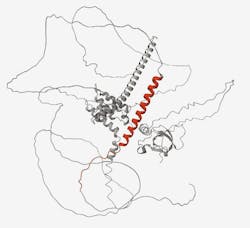Abnormal proteins found in the spinal fluid of people with ALS and frontotemporal dementia
Researchers at the National Institutes of Health detected abnormal proteins in the spinal fluid of people with amyotrophic lateral sclerosis (ALS) and frontotemporal dementia (FTD), which could help improve diagnosis of these diseases. The findings were published in Science Translational Medicine.
The proteins in question are built from “cryptic” exons—abnormal portions of RNA, the cell’s instructions for how to build proteins. Cryptic exons occur when TDP-43, a protein that regulates how RNA is processed, stops functioning normally. TDP-43 dysfunction is linked to ALS, FTD, Alzheimer’s disease, and Limbic Associated TDP-43 Encephalopathy (LATE).
The study showed that these mis-spliced sections of RNA can sometimes generate new proteins from the cryptic sequence. The findings advance our understanding of how cryptic exons may be involved in the dementia disease process and could help identify diseases involving TDP-43 dysfunction before symptoms appear. Currently, TDP-43 aggregates in the brain can only be detected at autopsy.
Normally, TDP-43 helps control the production of proteins by regulating how RNA is processed. To function properly, TDP-43 must remain in the cell nucleus, where DNA is located. In ALS and other neurodegenerative diseases, TDP-43 leaks from the nucleus and instead forms abnormal clumps in the surrounding cytoplasm.
Using induced pluripotent stem cells (iPSCs) that model neurodegenerative disease, the research team developed a catalog of cryptic exons, and were able to identify 65 peptides that came from 12 cryptic exons. They then identified those same cryptic exons in post-mortem brain samples taken from people who had ALS/FTD spectrum disease and compared them to healthy controls. The team followed up by confirming the presence of new resulting proteins in patient-derived iPSCs. They also showed that proteins containing cryptic sequences interacted with other proteins differently, likely altering their function.
The authors raised the possibility that these new proteins might be seen as foreign by our immune system, thereby triggering inflammation that could contribute to neurodegeneration. Finally, the team examined cerebrospinal fluid from patients with ALS/FTD spectrum disorders and identified 18 new proteins encoded by cryptic exons in 13 genes.
In addition to advancing our understanding of the biologic processes that give rise to neuronal death in ALS, FTD, and other TDP-43-associated neurodegenerative diseases, the study’s finding of novel proteins in patients’ spinal fluid may enable early diagnosis and serve as biomarkers that reflect a therapeutic response in clinical trials.





